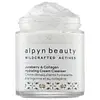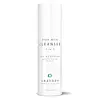What's inside
What's inside
 Key Ingredients
Key Ingredients

 Benefits
Benefits

 Concerns
Concerns

 Ingredients Side-by-side
Ingredients Side-by-side

Water
Skin ConditioningHelianthus Annuus Seed Oil
EmollientCetyl Alcohol
EmollientGlycerin
HumectantCetearyl Alcohol
EmollientCetearyl Olivate
Sorbitan Olivate
EmulsifyingTheobroma Cacao Seed Butter
EmollientPropanediol
SolventKaolin
AbrasiveDecyl Glucoside
CleansingBakuchiol
AntimicrobialCollagen
MoisturisingJojoba Esters
EmollientAmelanchier Alnifolia Fruit Extract
Skin ConditioningSclerotium Gum
Emulsion StabilisingCetearyl Glucoside
EmulsifyingCaprylyl Glycol
Emollient1,2-Hexanediol
Skin ConditioningSodium Lauroyl Sarcosinate
CleansingAcacia Senegal Gum
MaskingXanthan Gum
EmulsifyingCitric Acid
BufferingEucalyptus Globulus Leaf Oil
PerfumingTremella Fuciformis Polysaccharide
Emulsion StabilisingSalicylic Acid
MaskingMenthol
MaskingSimmondsia Chinensis Seed Oil
EmollientGlucose
HumectantIron Oxides
CI 77491
Cosmetic ColorantCaprylic/Capric Triglyceride
Masking3-O-Ethyl Ascorbic Acid
Skin ConditioningPistacia Lentiscus Gum
MaskingHydrogenated Lecithin
EmulsifyingPhenethyl Alcohol
MaskingEthylhexylglycerin
Skin ConditioningWater, Helianthus Annuus Seed Oil, Cetyl Alcohol, Glycerin, Cetearyl Alcohol, Cetearyl Olivate, Sorbitan Olivate, Theobroma Cacao Seed Butter, Propanediol, Kaolin, Decyl Glucoside, Bakuchiol, Collagen, Jojoba Esters, Amelanchier Alnifolia Fruit Extract, Sclerotium Gum, Cetearyl Glucoside, Caprylyl Glycol, 1,2-Hexanediol, Sodium Lauroyl Sarcosinate, Acacia Senegal Gum, Xanthan Gum, Citric Acid, Eucalyptus Globulus Leaf Oil, Tremella Fuciformis Polysaccharide, Salicylic Acid, Menthol, Simmondsia Chinensis Seed Oil, Glucose, Iron Oxides, CI 77491, Caprylic/Capric Triglyceride, 3-O-Ethyl Ascorbic Acid, Pistacia Lentiscus Gum, Hydrogenated Lecithin, Phenethyl Alcohol, Ethylhexylglycerin
Camellia Sinensis Leaf Extract
AntimicrobialCoco-Caprylate/Caprate
EmollientCaprylic/Capric Triglyceride
MaskingGlyceryl Stearate
EmollientCoco-Caprylate
EmollientSodium Olivoyl Glutamate
CleansingCetearyl Alcohol
EmollientCetyl Alcohol
EmollientStearyl Alcohol
EmollientPrunus Armeniaca Kernel Oil
MaskingNiacinamide
SmoothingCoco-Betaine
CleansingGlycerin
HumectantPhenethyl Alcohol
MaskingPentylene Glycol
Skin ConditioningPropanediol
SolventLauryl Glucoside
CleansingPolyglyceryl-2 Dipolyhydroxystearate
Skin ConditioningAloe Barbadensis Leaf Juice
Skin ConditioningDicaprylyl Carbonate
EmollientTocopherol
AntioxidantXanthan Gum
EmulsifyingSodium Stearoyl Glutamate
CleansingCitrus Paradisi Peel Oil
MaskingCitrus Aurantium Dulcis Peel Oil
MaskingPelargonium Graveolens Flower Oil
MaskingCamellia Sinensis Leaf Extract, Coco-Caprylate/Caprate, Caprylic/Capric Triglyceride, Glyceryl Stearate, Coco-Caprylate, Sodium Olivoyl Glutamate, Cetearyl Alcohol, Cetyl Alcohol, Stearyl Alcohol, Prunus Armeniaca Kernel Oil, Niacinamide, Coco-Betaine, Glycerin, Phenethyl Alcohol, Pentylene Glycol, Propanediol, Lauryl Glucoside, Polyglyceryl-2 Dipolyhydroxystearate, Aloe Barbadensis Leaf Juice, Dicaprylyl Carbonate, Tocopherol, Xanthan Gum, Sodium Stearoyl Glutamate, Citrus Paradisi Peel Oil, Citrus Aurantium Dulcis Peel Oil, Pelargonium Graveolens Flower Oil
Ingredients Explained
These ingredients are found in both products.
Ingredients higher up in an ingredient list are typically present in a larger amount.
This ingredient is an emollient, solvent, and texture enhancer. It is considered a skin-softener by helping the skin prevent moisture loss.
It helps thicken a product's formula and makes it easier to spread by dissolving clumping compounds.
Caprylic Triglyceride is made by combining glycerin with coconut oil, forming a clear liquid.
While there is an assumption Caprylic Triglyceride can clog pores due to it being derived from coconut oil, there is no research supporting this.
Learn more about Caprylic/Capric TriglycerideCetearyl alcohol is a mixture of two fatty alcohols: cetyl alcohol and stearyl alcohol. It is mainly used as an emulsifier. Emulsifiers help prevent the separation of oils and products. Due to its composition, it can also be used to thicken a product or help create foam.
Cetearyl alcohol is an emollient. Emollients help soothe and hydrate the skin by trapping moisture.
Studies show Cetearyl alcohol is non-toxic and non-irritating. The FDA allows products labeled "alcohol-free" to have fatty alcohols.
This ingredient is usually derived from plant oils such as palm, vegetable, or coconut oils. There is debate on whether this ingredient will cause acne.
Due to the fatty acid base, this ingredient may not be Malassezia folliculitis safe.
Learn more about Cetearyl AlcoholCetyl Alcohol is a fatty alcohol. Fatty Alcohols are most often used as an emollient or to thicken a product.
Its main roles are:
Though it has "alcohol" in the name, it is not related to denatured alcohol or ethyl alcohol.
The FDA allows products labeled "alcohol-free" to have fatty alcohols.
Learn more about Cetyl AlcoholGlycerin is already naturally found in your skin. It helps moisturize and protect your skin.
A study from 2016 found glycerin to be more effective as a humectant than AHAs and hyaluronic acid.
As a humectant, it helps the skin stay hydrated by pulling moisture to your skin. The low molecular weight of glycerin allows it to pull moisture into the deeper layers of your skin.
Hydrated skin improves your skin barrier; Your skin barrier helps protect against irritants and bacteria.
Glycerin has also been found to have antimicrobial and antiviral properties. Due to these properties, glycerin is often used in wound and burn treatments.
In cosmetics, glycerin is usually derived from plants such as soybean or palm. However, it can also be sourced from animals, such as tallow or animal fat.
This ingredient is organic, colorless, odorless, and non-toxic.
Glycerin is the name for this ingredient in American English. British English uses Glycerol/Glycerine.
Learn more about GlycerinPhenethyl Alcohol is a colorless and aromatic alohol. It is naturally occuring in essential oils.
The scent of this ingredient is floral and often compared to rose.
Like other alcohols, this ingredient helps prevent the growth of bacteria. However, its main purpose is to impact a fragrance.
Learn more about Phenethyl AlcoholPropanediol is an all-star ingredient. It softens, hydrates, and smooths the skin.
It’s often used to:
Propanediol is not likely to cause sensitivity and considered safe to use. It is derived from corn or petroleum with a clear color and no scent.
Learn more about PropanediolXanthan gum is used as a stabilizer and thickener within cosmetic products. It helps give products a sticky, thick feeling - preventing them from being too runny.
On the technical side of things, xanthan gum is a polysaccharide - a combination consisting of multiple sugar molecules bonded together.
Xanthan gum is a pretty common and great ingredient. It is a natural, non-toxic, non-irritating ingredient that is also commonly used in food products.
Learn more about Xanthan Gum